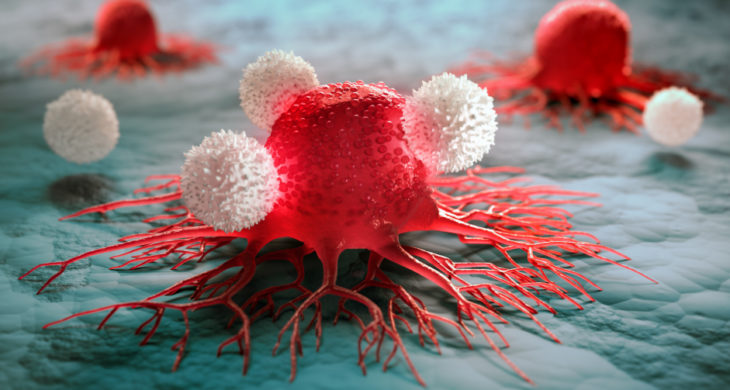
Date: 7th October 2020
Cancer immunotherapy has been transformed by the knowledge that immune checkpoint pathways are often activated in malignant cells and inhibit the nascent anti-tumour immune response. Immune checkpoint therapies act by blocking or stimulating these pathways and enhance the body’s immunological activity against tumours. However, accurate monitoring of immunotherapy efficacy is challenging due to heterogeneous immune responses. Now scientists have designed a granzyme B (GrB) nanoreporter (GNR) that can deliver an immune checkpoint inhibitor to the tumour and can be used to monitor initiation of effective immune responses.
Granzyme B (GrB) is one of the most prominent serine proteases involved in the cytotoxic effect of T cells and could potentially be used to enable direct monitoring of the response to cancer immunotherapy. It could provide an early indicator of whether a cancer would respond or not to treatment. So scientists from the University of Massachusetts, US, led by Ashish Kulkarni, have exploited GrB by developing a GrB nanoreporter (GNR) which is stimuli-responsive and can be used to monitor GrB activity both in vitro and in vivo.
The team designed the GNR as a functional activity–based GrB imaging probe and consisted of stimuli-responsive polymers conjugated with an immunotherapy drug and activatable GrB imaging probe. The imaging probe consists of a GrB-responsive peptide sequence and a fluorescent dye-quencher pair conjugated on either side of the GrB-cleavable peptide sequence.
So how does the platform work?
In theory in highly immunogenic tumours, the immunotherapy drug should result in cytotoxic T cell–mediated cancer cell killing by the release of GrB. The released GrB would cleave the Grb-responsive peptide sequence, releasing the dye from the quencher and activating the fluorescent signal. In contrast, in the case of poorly immunogenic tumours, a partial response resulting from lower cytotoxic T cell activity and lower GrB release would fail to activate the fluorescent signal, and the signal remains in the “off” condition. This GrB-mediated fluorescence activation should allow direct visualisation of the T cell activity in the tumour and should distinguish between immune-responsive and poorly responsive tumours.
Characterisation of GNRs
The nanoreporter system was designed so the immunotherapy drug and GrB imaging probe were delivered using a single nanoparticle to the same cell to maximise the real-time imaging of time-sensitive GrB enzyme activity. Here, the team used an anti–PD-L1 (anti–programmed death-ligand 1) antibody as the immunotherapy drug, which they conjugated to the nanoreporter surface.
First the team checked that the GRNs were not toxic to a cancer cell line, and showed that the anti–PD-L1 antibody conjugation on the GNRs surface retained its binding to PD-L1 on cancer cells which resulted in its efficient uptake by the cells. The GNRs were then used in an in vitro co-culture system where T cells and cancer cells were mixed, here the GNRs allowed efficient and selective monitoring of T cell activity against the cancer cells by measuring fluorescence and confocal imaging.
In vivo testing
The team then wanted to test whether GNRs could enable monitoring of anti–PD-L1 treatment in real time, so they used two tumour models in mice, one highly responsive and the other poorly responsive. Both tumours were inoculated into different flanks of the same animal, and then 7 days later they were treated intravenously with the GNRs. A fluorescence signal due to activation of the GrB imaging probe was detected in highly responsive tumours as early as 24 hours after the first dose of αPDL1-GNRs, whilst none was detected in the poorly responsive tumour. Furthermore, over time the GNRs could distinguish between the two tumours seen as significantly higher fluorescence in the highly responsive tumour. This was also associated with the highest infiltration of CD8+ T cells and the highest release of GrB as compared with other control treatment groups and with the poorly responsive tumour.
The data so far supported the use of GNRs to monitor immunotherapy responses in real time and allowed distinction in treatment efficacies between different tumour types. However, the team wanted to determine whether the response in poorly immunogenic tumours could be enhanced by increasing the GNR dosage. Indeed, this was the case, and it allowed real-time monitoring of immunotherapy treatment efficacy in these tumours, which again was associated with higher infiltration of CD8+ T cells, increased levels of GrB, and an increased number of apoptotic cells when compared with the lower dose of GNRs.
Conclusions and future applications
GNRs enabled real-time immunotherapy response monitoring in a tumour-bearing mice model, and were able to distinguish between highly responsive and poorly responsive tumours. The findings here indicate that GNR have the potential to serve as a tool for sensitive and non-invasive evaluation of immunotherapy efficacy.
The development of a tool such as GNRs that can concurrently deliver immunotherapy agents and track the T cell–mediated GrB activity in real time should be a valuable tool for clinicians. It will help to determine which patients are responding to treatments, and will support an early change to alternative therapies if they are not. It should allow a more comprehensive overview of the immune response after immunotherapy treatments, and could also be used as a tool to monitor new immunotherapy treatments.
New immunotherapies such as we reported last month where CAR T cell therapy was combined with an oncolytic virus delivery of a CAR-targetable tumour antigen to target and eradicate solid tumours in mice. With the translation of this new combination approach being readied for clinical trials, the ability of GNRs to monitor the immune response could be an additional valuable tool for such studies.
Nguyen, A., A. Ramesh, S. Kumar, D. Nandi, A. Brouillard, A. Wells, L. Pobezinsky, B. Osborne and A. A. Kulkarni (2020). “Granzyme B nanoreporter for early monitoring of tumor response to immunotherapy.” Science Advances 6(40): eabc2777.
https://doi.org/10.1126/sciadv.abc2777


